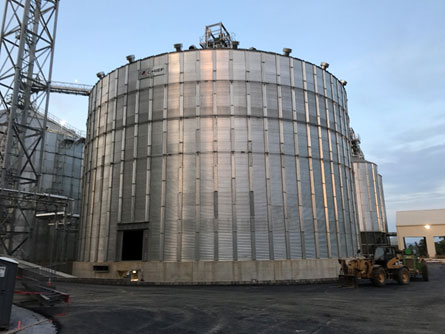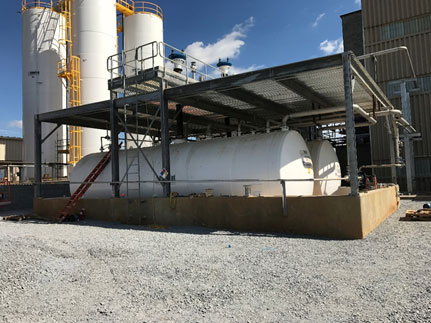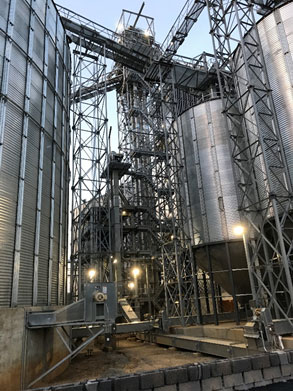
This is part 2 of Eric Bachman’s article on preincident intelligence of buildings under construction. Read part one HERE.
By Eric Bachman
CASE STUDY 2
Engaging in preincident intelligence from the ground up is not only beneficial for recognizing and assessing construction methodology but may also result in the need to study, learn, and assess new industrial processes and associated hazards and challenges. This case study highlights the construction of a unique industrial process that took the facility years to obtain the necessary construction and environmental permits. It also faced numerous public hearings because of opposition from local citizens. The public controversy regarding this site centered around the process use of hexane and the potential for air polluting emissions.
Construction of a soybean oil processing facility had been planned for nearly seven years. During the planning process, the company met with Local Fire Department (LFD) officials to review the layout of the complex, illustrate associated processes, and corroborate on emergency service preparedness and delivery. The basic process is explained below.

(6) The facility constructed three 500,000-bushel capacity grain bins, which present an engulfment potential.
The facility brings in truckloads of soybeans, which are conveyed into large storage bins (Photo 6). The soybeans are distributed to other storage vessels for drying and moisture control through a series of nearly below-grade and high-rise conveyors (Photo 7). Then the soybeans enter a multi-story extractor building (Photo 8), where hexane is introduced to separate the oil. This process results in producing both oil and meal. The meal is used in animal feed. The oil is used in a myriad of applications, ranging from salad dressing to biodiesel. Both by-products are trucked off site.

(7) Below grain bin conveyor corridors present a limited access/confined space potential.
The physical layout of the facility features limited access along with numerous buildings and varied capacity and height storage structures. Some of the storage and conveyor structures are more than 100 feet above grade and employ a series of ascending catwalks for staff access.
The primary dry grain storage bins each have capacity of more than 500,000 bushels. Constructed below the storage bins are conveyors, which transport soybeans to dryers and other processing areas. The extractor building is four stories and uses hexane, which is classified as a Class I Flammable Liquid. Because of hexane’s flammability characteristic (flammable range between 1.2 and 7.7 percent), the building employs several monitoring devices and protection elements designed for early detection and suppression. Operational protocols within this building include pre-entry processes to eliminate potential ignition sources. This has been well-communicated to LFD officials, who have developed specific standard operating procedures (SOPs) for operating at facility emergencies.

(8) Hexane storage area with liquid containment is built within a larger vapor containment area.
The facility maintains two 20,000 gallon above-ground hexane storage tanks (Photo 8), which are installed in accordance with National Fire Protection Association (NFPA) Standard 36, Standard for Solvent Extraction Plants. The hexane tanks are located within a precisely constructed ‘vapor containment’ area, which is a requirement of NFPA 36.
The area surrounding the complex is not supported by a municipal water system. The facility maintains a 500,000-gallon storage tank with a 5,000-gpm fire pump to support the extraction building suppression system, along with a looped system of fire hydrants.
The LFD was involved during various stages of development and construction, which provided it with a better appreciation and understanding of the hazards and supported SOP development for the site. It also heightened the rapport with facility personnel, which is a tremendous asset for pre- and postdispatch operational coordination.
Recognizing the hazards enables the LFD to be better informed and prepared. LFD officials studied the Hexane Safety Data Sheets to understand its physical and chemical characteristics. It also allowed for review of NFPA 36 with regard to tank installation positioning and fire protection.

(9) Catwalks along and among other silos present access and high angle rescue potential
The facility reviewed incidents that occurred or could potentially occur at similar facilities, such as the combustible dust potential especially within the drying process. The potential for high-angle rescue events along the silo catwalks (Photo 9), confined space incidents (in the conveyor corridors under the grain bin) and engulfment (within the grain bin) has bolstered the preincident preparedness of the LFD. The result has been firefighters btaining training and refining specific fire and rescue skills for identified hazards as well as developing and maintaining a resource list for specialized technical rescue resources. Facility management has verbally made commitments to sponsor specific training for the LFD response needs to the facility.
The LFD also sought assistance from the county Local Emergency Planning Committee (LEPC) to support off-site consequence planning with regard to hexane incidents as well as sulfuric acid, which is on-site for use in pH control of the ground water supplied ‘domestic’ system,
*
When you monitor a facility built from the ground up and follow its progress, it provides improved preincident intelligence, heightens the level of situational awareness, creates a more personal vested interest, and ultimately improves responder safety. The examples presented above were at different ends of the proverbial “target hazard” scale, but nonetheless provided a preparedness improvement opportunity to the respective LFD. The opportunity to be a part of or observe the development or construction of a new venue can be few and far between. When the opportunity presents itself, take advantage of it, because your life may depend on it.
ERIC G. BACHMAN, CFPS, is a 35-year veteran of the fire service and a former chief of the Eden Volunteer Fire/Rescue Department in Lancaster County, Pennsylvania. He is the hazardous materials administrator for the County of Lancaster Emergency Management Agency and serves on the Local Emergency Planning Committee of Lancaster County. He is registered with the National Board on Fire Service Professional Qualifications as a fire officer IV, fire instructor III, hazardous materials technician, and hazardous materials incident commander. He has an associate degree in fire science and earned professional certification in emergency management through the state of Pennsylvania. He is also a volunteer firefighter with the West Hempfield (PA) Fire & Rescue Company.
It’s Not a Cliché: Words To Live by
Occupancy Classifications: An Orientation

